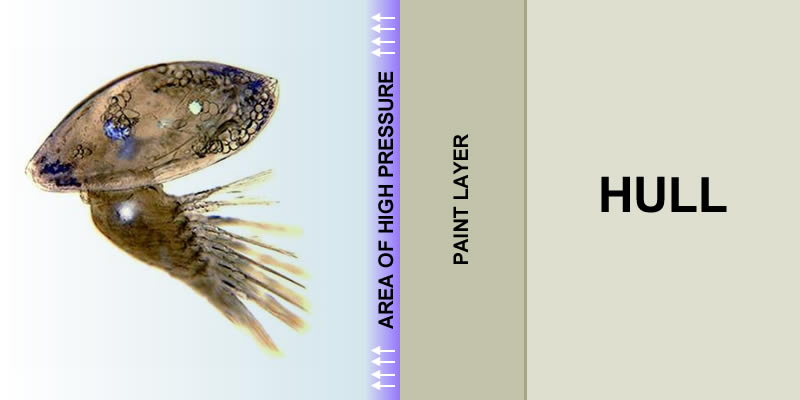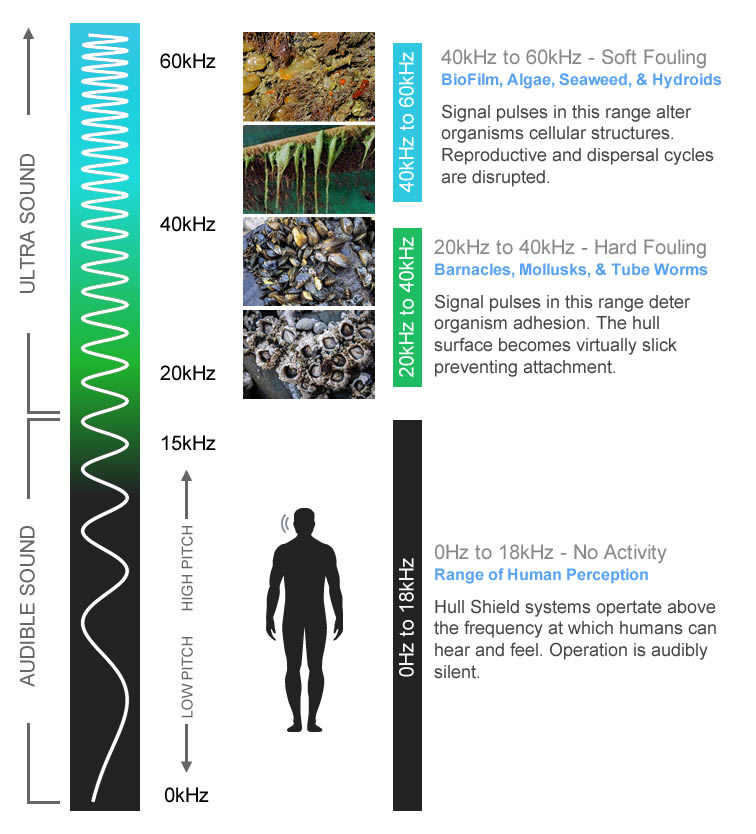Learn How Hull Shield's Ultrasonic Anitfouling Technology Works
Marine Fouling & Anti-Fouling Technologies
Fouling is the process of marine organisms attaching and growing on surfaces below the waterline. The most common method to fight back against fouling is the use of bottom paint.
Bottom paints and bottom coatings are available in a variety of formulations to help slow fouling. These bottom paints can include combinations of toxins, chemicals, and mechanical properties – the purpose is to prevent marine organisms from attaching to your underwater surfaces.
Bottom paint alone is not a very effective method of stopping marine fouling. Most all boats which are kept in the water must be routinely cleaned to remove the excessive fouling, with the bottom paint most effectively just providing an easily cleanable surface, protecting the hull from damage created by fouling and abrasive cleaners.
Ultrasonic antifouling provides much more prevention when compared to bottom paint alone. When ultrasonic antifouling is combined with bottom paint, a more effective solution is achieved, with the ultrasonic effect providing long periods between needed bottom cleaning, while the bottom paint provides physical protection of the hull and an easier, less damaging, cleaning experience.
Effects of Ultrasonic Stimulation
Ultrasounds are frequencies above that which can be heard or perceived by people. Ultrasound equipment is a large part of our daily lives and includes devices such vehicle parking sensors, ultrasound imaging in hospitals, and sonar on boats. Just as the frequency of light can produce a wide variety of phenomena such as radio, visible light, and microwaves, the same is true for sound – different frequencies will produce diverse effects ranging from imaging, communication signals, and mechanical vibration.
Different frequencies affect marine fouling in different ways. Ultrasounds between 20kHz and 40kHz produces a high pressure barrier along a surface. This microscopic barrier is only a few microns thick. Small organisms cannot occupy this high pressure space and are prevented from attaching, and repelled, from the surface.

Other frequencies have a different type of function. At frequencies above 40kHz, the cellular structure of fouling organisms that have attached to the surface begins to be effected. Common tasks related to organism life processes and reproduction cycles are disrupted within this frequency range.
Ultrasonic antifouling achieves a cleaner hull and running gear in two ways. First, by preventing new fouling from attaching to the protected surfaces. The second function is the disruption of fouling organisms ability to reproduce and spread across the protected surfaces. It’s important to remember that an ultrasonic anti-fouling system will not reverse existing fouling that was present on the hull prior to the system being installed – the effects of ultrasonic antifouling are preventative.

Implementation of Ultrasonic Antifouling
Unlike audible sound waves which can travel great distances through the air, ultrasound is most effectively transmitted through dense rigid surfaces. Consider ground penetrating radar – ultrasound can be utilized to create mapped images of depths over 100 feet through solid rock. Likewise, the ultrasound produced by Hull Shield systems spread through surfaces that are to be protected.
Hull Shield systems provide ultrasonic emitters which are bonded directly to the hull surface at evenly spaced intervals. These ultrasonic emitters transmit ultrasound into the hull and protected surfaces. The transmitters receive signals from a fully automatic control unit which is centrally located in the boat.
Experience a cleaner hull
Full time water line and below protection.


To install this Web App in your iPhone/iPad press
![]() and then Add to Home Screen.
and then Add to Home Screen.
